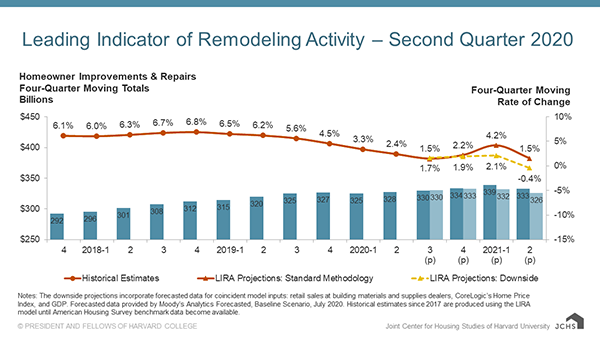Pandemic to Weigh on Home Remodeling Spending Through Mid-Year 2021

CAMBRIDGE, MA – Expenditures for improvements and repairs to owner-occupied homes are expected to slow by the middle of next year as the COVID-19 pandemic continues to unfold, according to the Leading Indicator of Remodeling Activity (LIRA) released today by the Remodeling Futures Program at the Joint Center for Housing Studies of Harvard University. Assuming continued weakness in the broader economy due to the public health crisis, the LIRA projects annual declines in renovation and repair spending of 0.4 percent by the second quarter of 2021. With the unprecedented changes to the US economy since mid-March, the Remodeling Futures Program is again providing this downside range for the home remodeling outlook, which incorporates forecasts for several core model inputs: retail sales of building materials, home prices, and GDP. In contrast, the LIRA’s standard methodology, which does not include forecasted trends, would have called for increasing remodeling activity through the start of next year.
“The remodeling market was buoyed through the early months of the pandemic as owners spent a considerable amount of time at home and realized the need to update or reconfigure indoor and outdoor spaces for work, school, play, exercise, and more,” says Chris Herbert, Managing Director of the Joint Center for Housing Studies. “However, sharp declines in home sales and project permitting activity this spring, as well as record unemployment, suggest many homeowners will likely scale back plans for major renovations this year and next.”
“As the pace of do-it-yourself activity, maintenance work, and exterior-focused projects begins to taper, annual expenditures by owners for home improvements and repairs are expected to shrink slightly to $326 billion by the middle of 2021,” says Abbe Will, Associate Project Director in the Remodeling Futures Program at the Center. “Given the ongoing uncertainty surrounding the broader impact of the pandemic, the timing on when we’ll reach a bottom in the remodeling market also remains unclear.”
Click image for full-size chart.
The Leading Indicator of Remodeling Activity (LIRA) provides a short-term outlook of national home improvement and repair spending to owner-occupied homes. The indicator, measured as an annual rate-of-change of its components, is designed to project the annual rate of change in spending for the current quarter and subsequent four quarters, and is intended to help identify future turning points in the business cycle of the home improvement and repair industry. Originally developed in 2007, the LIRA was re-benchmarked in April 2016 to a broader market measure based on the biennial American Housing Survey.
The LIRA is released by the Remodeling Futures Program at the Joint Center for Housing Studies of Harvard University in the third week after each quarter’s closing. The next LIRA release date is October 15, 2020.
The Remodeling Futures Program, initiated by the Joint Center for Housing Studies in 1995, is a comprehensive study of the factors influencing the growth and changing characteristics of housing renovation and repair activity in the United States. The Program seeks to produce a better understanding of the home improvement industry and its relationship to the broader residential construction industry.
The Harvard Joint Center for Housing Studies advances understanding of housing issues and informs policy. Through its research, education, and public outreach programs, the Center helps leaders in government, business, and the civic sectors make decisions that effectively address the needs of cities and communities. Through graduate and executive courses, as well as fellowships and internship opportunities, the Center also trains and inspires the next generation of housing leaders.
Contact: Kerry Donahue, (617) 495-7640, [email protected]

